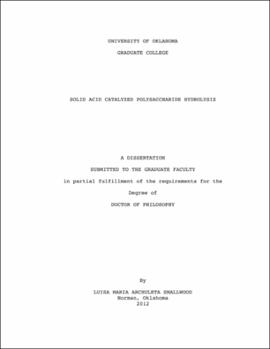| dc.description.abstract | In addition to the rising costs of gasoline and the depletion of fossil fuels, air pollution caused by burning fossil fuels has increased the need to develop alternative renewable fuels. One possible alternative is the conversion of renewable biomass to fuels. The ability to use cellulosic biomass instead of starch for ethanol production makes bioethanol an even more attractive renewable alternative fuel. The focus of the research described here is on the study and optimization of polysaccharide hydrolysis by using solid acid catalysts. Solid acid catalyst (SAC) candidates were identified for polysaccharide hydrolysis and then tested in both an aqueous medium and in an ionic liquid medium. Higher activities for amorphous SACs (sulfated zirconia, Nafion® SAC-13, and Nafion® NR50) were observed compared to the zeolites tested (HY and HZSM-5) for starch hydrolysis in aqueous media. However, Na+ enhancement of the aqueous media significantly increased the activity of HY and HZSM-5 for starch hydrolysis. Thus, it was determined that for zeolites to be active for cellulose hydrolysis, acid equivalents must be transported from the catalyst inner channels to the aqueous media, which can be accomplished by ion exchange. For polysaccharide hydrolysis in ionic liquid media, ion exchange induced proton release resulted in an observed catalytic activity for cellulose hydrolysis for all SACs tested (HY, HZSM-5, sulfated zirconia, Nafion® SAC-13, and Nafion® NR50). The mmol H+ transferred from each solid to the medium was found to be dependent on the catalyst acid site location and its availability to the ionic liquid cations. After protons are released into the medium, the resultant catalytic activity is comparable to adding the equivalent amount of a liquid strong acid, and this activity is not dependent upon the structure of the SAC from which the acid equivalents are derived. This irreversible release of acidic protons make reuse of these catalysts impractical. Necessary structural features that should be incorporated into the design of future reusable catalysts with greater activity were identified by the fundamental studies described here. | |
